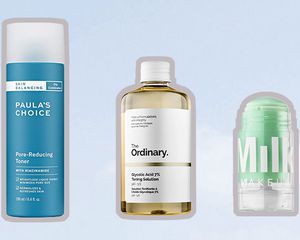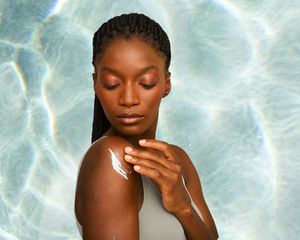
ohlamour studio / Stocksy
When it comes to important pieces of self-knowledge, we'd like to argue that knowing your skin type is perhaps one of the most worthwhile bits of information you can have. Skin typing is a very real thing and is extremely helpful when it comes to choosing products and creating an effective skincare routine.
Knowing your skin type allows you to better understand what products will benefit your skin and which could end up potentially doing more harm than good, says board-certified dermatologist Aanand Geria, MD. "Most OTC skincare isn't 'one size fits all,' so knowing your skin type allows you to choose the products and ingredients that best suit your skin's needs and will both treat existing problems and ward off future issues," he explains.
So, what exactly are the differences between the skin types, and how should they be treated differently? Ahead, Geria, along with board-certified dermatologists Christina Chung, MD, Hadley King, MD, and Geeta Yadav, MD, weigh in. Plus, they share a super easy method for figuring out exactly what kind of skin you have.
Meet the Expert
- Aanand Geria, MD, is a board-certified dermatologist based in Verona, New Jersey.
- Christina Chung, MD, is a board-certified dermatologist at Schweiger Dermatology Group in Philadelphia.
- Hadley King, MD, is a board-certified dermatologist based in New York City.
- Geeta Yadav, MD, is a board-certified dermatologist based in Toronto.
What Is Skin Typing?
"Skin typing is understanding how your skin exists naturally at a point in time," explains Chung. "Everyone has a different biological setting for their skin, and is genetically programmed to produce different levels of oil." This is the main criteria that determines your skin type. It bears mentioning that, while skin type is primarily determined by genetics, King says it can also be influenced by other factors. For example, certain medications, age, and even the environment/climate can affect it.
The key point here is that each of the different skin types has different needs, and having a better understanding of what these are and choosing the right products accordingly will leave your complexion looking and feeling good.
How to Tell Which Skin Type You Have
"Perhaps the biggest mistake people make when determining their skin type is not assessing the skin at its baseline," says Yadav. For example, just because you have a sudden breakout doesn't mean you're acne-prone, and just because your skin gets drier in the winter doesn't necessarily mean you have dry skin.
In order to accurately determine the natural baseline of your skin, try this simple, expert-recommended technique. Wash your face (with a gentle, mild cleanser), pat it dry, and don't apply any other products. Wait 30 minutes, then assess how your skin looks and feels. "If your face appears shiny all over, you likely have oily skin. If it's only shiny on the t-zone, that translates to combination skin. If your skin feels tight and looks dull, you have dry skin. And if it's very irritated and uncomfortable, you have sensitive skin," says Yadav. Yes, it's just that easy.
The Different Skin Types
Keep reading for some more detailed info on five various skin types.
Oily Skin
"Oily skin often appears shiny due to excess oil production," notes Yadav. She adds that excess oil can make pores appear larger and more prominent. (Note: While unwanted sheen and oil tend to be concentrated in the t-zone, it can extend across the entire face in those with oily skin types.)
When it comes to choosing products, one of the biggest misconceptions is that oily skin doesn't need moisture, says Geria. That's totally false: You do still need to use a moisturizer. The key is choosing the right kind; specifically, opting for non-comedogenic, lightweight, oil-free formulas is your best bet, he says. He adds that foaming cleansers, which effectively remove excess oil, are also good to add to your routine.
Dry Skin
Common characteristics of dry skin include a dull appearance, flaking, and even a tight or uncomfortable sensation, says Yadav. The antidote? Adding back as much moisture as possible. That means using products that contain a combination of humectants, ingredients that attract water to the skin, as well as emollients, ingredients that help seal it in, soften, and smooth the surface of the skin, she says.
Top tip: Look for moisturizers that come in jars, which tend to be richer than those that come in pump bottles, Chung suggests. And when it comes to cleansers, King advises steering clear of soaps; they can strip skin of its natural oils and leave it even dryer. Instead, she recommends seeking out creamy, non-soap cleansers, or cleansing oils, milks, or balms.
Combination Skin
As the name suggests, this kind of skin has some traits from both of the above, with certain areas skewing toward oily and others skewing toward dry. Most commonly, the cheeks and perioral area tend to be dry and the nose and forehead more oily, Chung points out.
It's admittedly tricky to find the right products for this skin type. Stick with a mild, gentle cleanser, then use different formulas on different parts of your face. For example, use more lightweight, oil-free moisturizers on your t-zone and creamier ones on your cheeks, says Chung. "Follow a gentle skincare regimen overall, but be attentive to your skin's needs and adjust your daily routine accordingly, rotating products to give your skin what it needs that day," Yadav advises.
Acne-Prone Skin
Those with acne-prone skin tend to have a bumpy texture due to blackheads and whiteheads and break out easily, says Chung. "You'll also see skin inflammation, which goes hand-in-hand with breakouts," adds Yadav.
There is quite a bit of overlap between the oily and acne-prone types; after all, excess oil is a key contributing factor to the formation of pimples and blemishes. As such, the same rules apply when it comes to choosing lightweight, non-comedogenic moisturizers and foaming cleansers. But King says you may also want to add in products that contain ingredients such as salicylic acid, benzoyl peroxide, and retinoids, all of which are helpful for preventing and treating acne.
Sensitive Skin
According to Geria, people often incorrectly put themselves into this category. Their skin reacts to a strong ingredient—think something like glycolic acid or retinol—and they assume their skin is sensitive; in reality, it's just that it's a potent ingredient that their skin hasn't yet built up a tolerance for, and that can happen in any skin type, he says. If you truly have sensitive skin, it will get hot, red, itchy, and/or irritated from things such as showers, exercise, and even gentle skincare products. Those with sensitive skin are also often diagnosed with eczema, rosacea, or dermatitis, he adds.
Sticking with the same product criteria as that for dry skin is a good move, as there is often an overlap between the two. (Credit a compromised skin barrier, which can contribute to both dryness and increased sensitivity.) But you'll also want to opt for fragrance-free formulas and those that generally have simpler, more minimal ingredient lists; the fewer the ingredients, the lower the likelihood that one of them will irritate.
The Final Takeaway
Knowing your skin type may just be the single best way to find products that are actually going to work for you. Even if you think you know what it is, keep in mind that it can change over time—just because you were oily at 16, it doesn't mean you still will be at 36—so it's worth trying the quick DIY technique to reassess the situation.
















